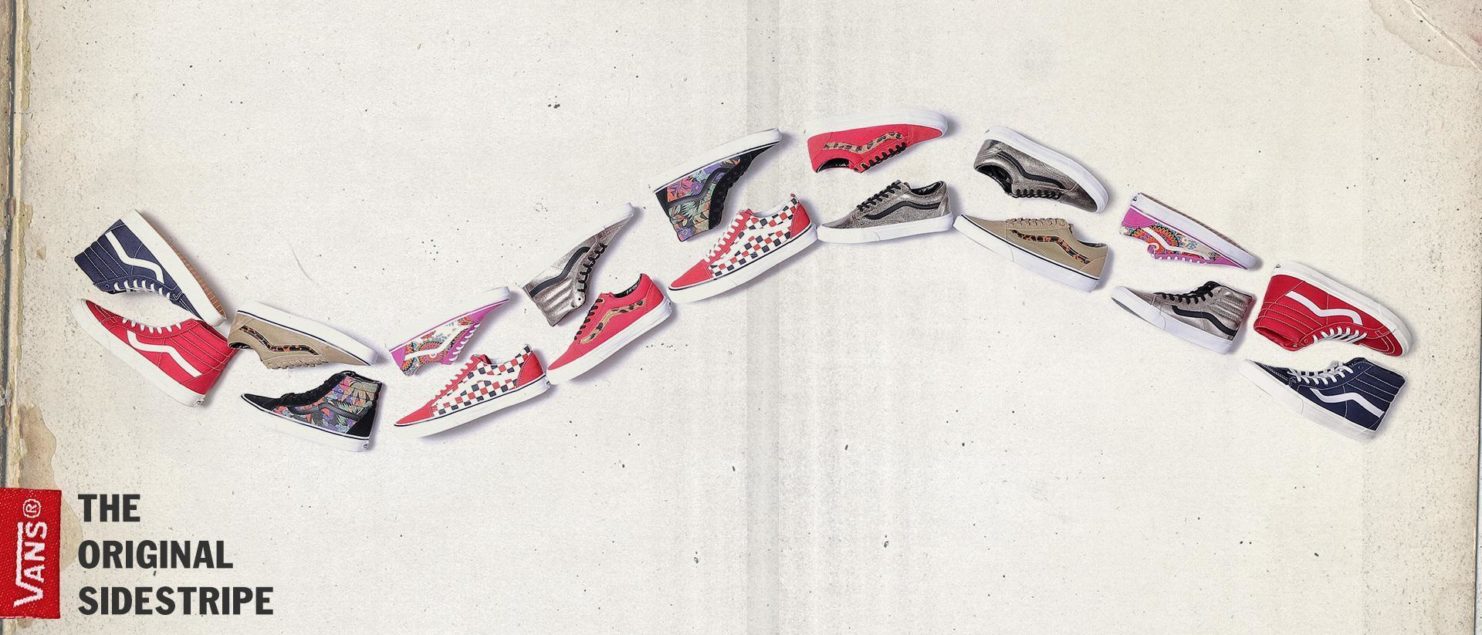Ridin’ on the wave.
I love my pair of Vans.
In themselves, nothing special : it’s a very classic pair of model #38 (Sk8-Hi), with its rising silhouette, black leather and canvas, white stitching and thick white sole.
Light, comfortable : they can be matched with anything.
And then there is this “wave”, this simple stripe of white leather that runs along the quarters of the shoe and makes it instantly recognizable.
I don’t consider myself as a sneakerhead, but I think it’s this stripe that has allowed the Vans to join the great Pantheon of the iconic shoe, alongside the Chuck Taylor Converses star, the Adidas three stripes, the ASICS Tiger Stripes or of course the legendary Nike Swoosh.
But what fascinates me the most is that unlike all the pairs of shoes that I just mentioned, the Vans Sidestripe isn’t a simple reproduction of the logo of the brand. Vans has succeeded in creating a unique, abstract symbol that has made the brand a part of mainstream visual culture without having to put their name or logo all over their pair of shoes.
A singular approach that summarizes alone the state of mind of Vans since its inception.
Founded in March 1966 on 704 East Broadway in Anaheim, California, the Van Doren Rubber Company’s first factory and boutique was created on a unique model : the pair of shoes ordered in-store is directly manufactured on-site and later recovered the same day by the customer.
A total of 12 pairs of style #44 (the Authentic) were sold and manufactured during the opening day.
But it is at the beginning of the 1970s that the Vans will find their main customer base through the emerging South Californian skateboard scene.
The founder Paul Van Doren always refused to spend money for advertising, so he decided to sponsor the best skateboarders he could find, like Tony Alva and Stacy Peralta by offering them free shoes. These two athletes will also be at the origin of the new Vans model that will become the standard for a generation of skaters : the style #95 (the Era), with a padded collar and multiple colors on the same shoe.
It was also at this time that the first version of the classic Vans logo was born, based of a stencil designed at age 13 by the young Mark Van Doren (son of James Van Doren, Paul’s brother and co-founder of the company) to paint the logo on his own skateboards.
The recent collaboration of model #95 in 1976 cemented the relationship between the sport and the brand through the birth of the « Off the Wall » Vans logo, phrase from californian jargon when a trick was made in the air after taking off the wall of an empty pool. The late 1970s also saw the birth of the last three flagship styles from Vans : the #98 (the Slip-ons) and the #36 (the Old Skool) in 1977, and finally the style #38 (the Sk8-Hi) in 1978.
Then first appeared the famous leather stripe, along styles #36 and #38.
The brand’s first shoes with leather quarters to improve durability, their new silhouette in search of comfort and functionality were suitable to the implementation of what will become the unmistakable symbol of the Vans in the future : the Sidestripe.
First called “Jazz Stripe” within the company, this symbol comes from a doodle of Paul Van Doren on a paper napkin, while searching an answer to the swoosh and other immediately recognizable stripes on sports shoes developed since the 1950s.
This “wave” symbol was largely inspired by another iconic design, but this time in the automotive industry. Indeed, Paul Van Doren had a weakness for American race cars, especially the 1967 Shelby Cobra which sported two exhaust pipes all along the doors. An American symbol inspired another in two industries where visual design has a real importance in the creative process.
The Sidestripe has undergone various adjustments since its inception, the original made in the United States was thinner and had a larger fold in the hollow of the “wave”. The originals of the time thus had more personality, and the hand-made nature of the first manufactured pairs explains a sometimes hazardous placement.
Now a Californian institution, it was a movie that gave the Vans their national and international fame in 1982 thanks to Sean Penn and his character Jeff Spicoli in Fast Times at Ridgemont High, wearing checkered Slip-ons that instantly caused a sensation.
The five styles of the brand lending themselves extremely well to the customization-spree that began in the 1980s with many patterns and colors available, Vans continued their collaborations with other alternative cultural scenes in the 1990s. Sponsoring the “Warped Tour” in 1995, Vans will also become synonymous with the punk music movement in the United States. The 2000’s and 2010’s will confirm the international cultural importance of Vans through many collaborations with artists and their image as Iron Maiden, Metalica, the Beatles, Led Zeppelin and David Bowie among others, fashion designer Marc Jacobs, Kenzo and Karl Lagerfeld, but also with huge popular brands like Disney, the Simpsons or Star Wars.
Always listening to their fans and all the cultural and urban niches that have adopted them to express their personal styles, the Vans and their Sidestripe continues to promote the singular vision of a brand that was original, rebellious and creative since the beginning.
In the end, that’s why I love my pair of Vans.
More than a pair of shoes, it’s a kind of symbol and statement to the world, to share the “Off the Wall” mindset, in the words of Steve Van Doren, son of Paul and current vice-president of the company : “this moment when everyone goes left and you decide to go right”.



